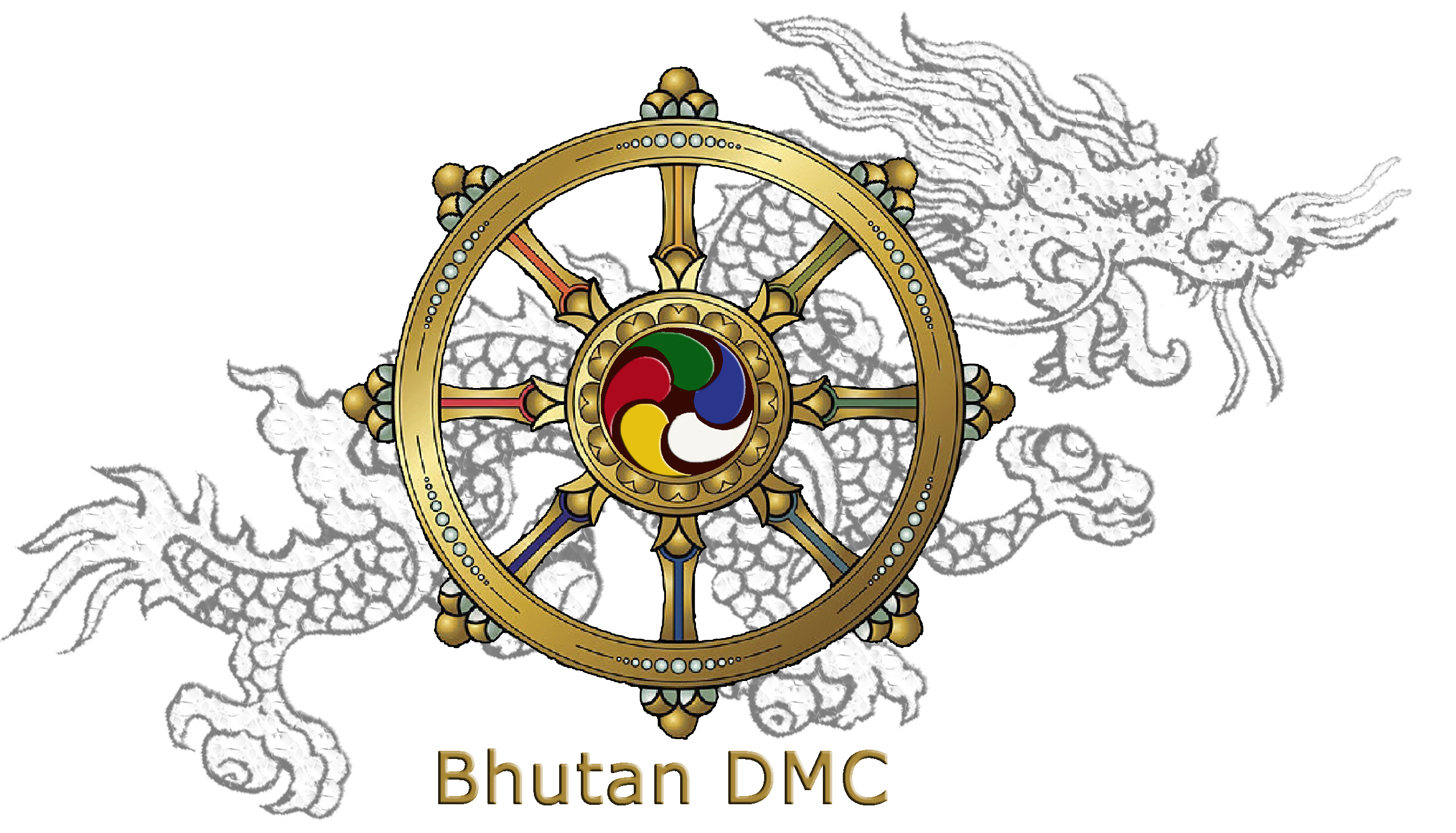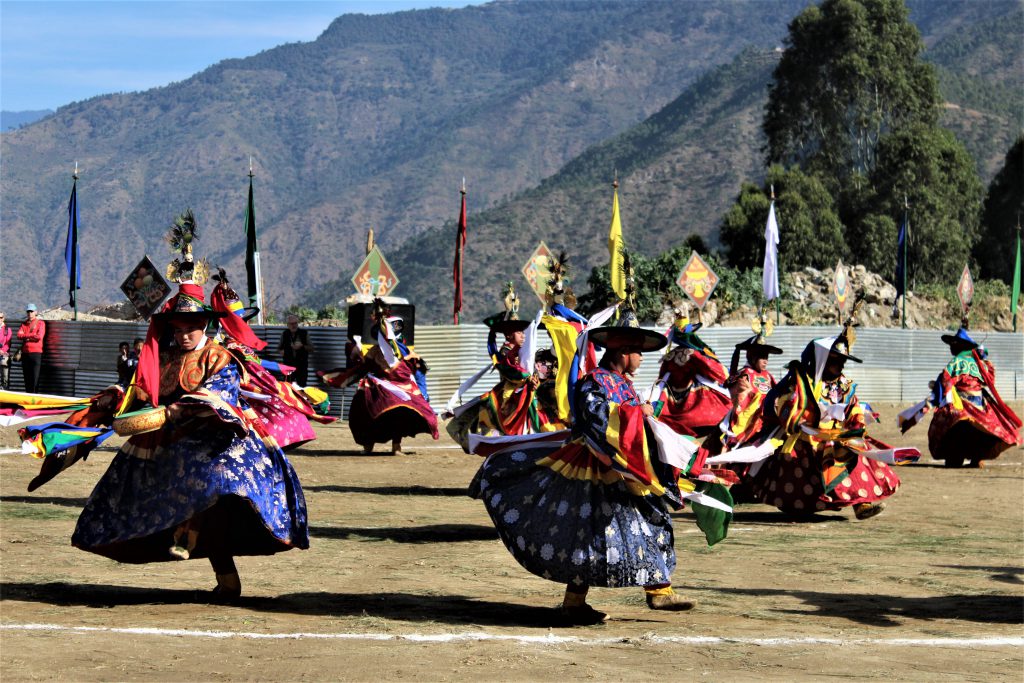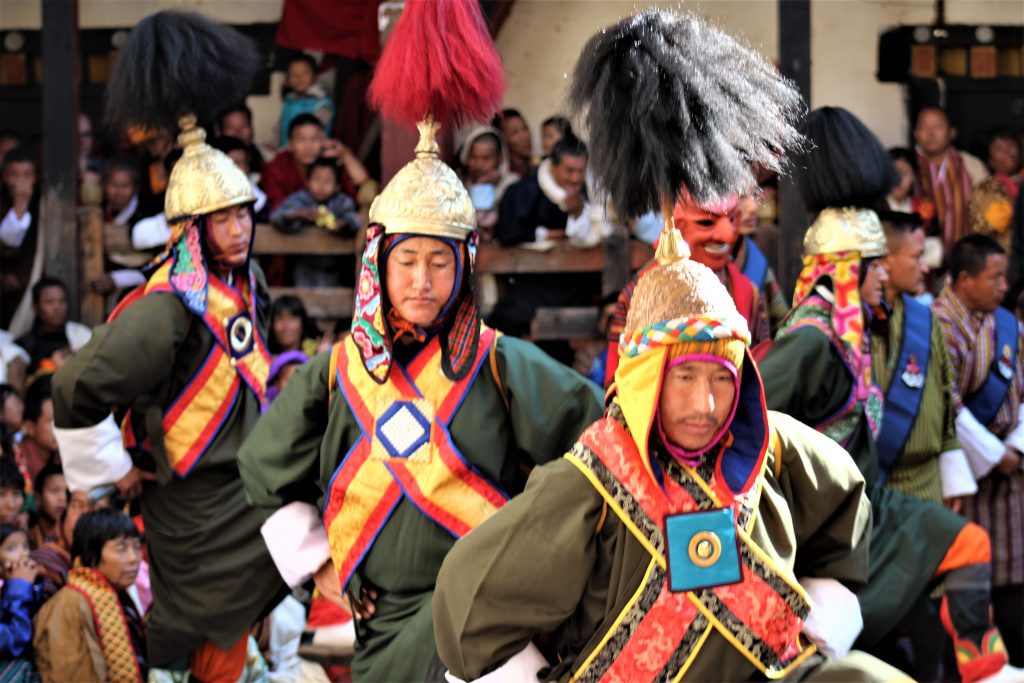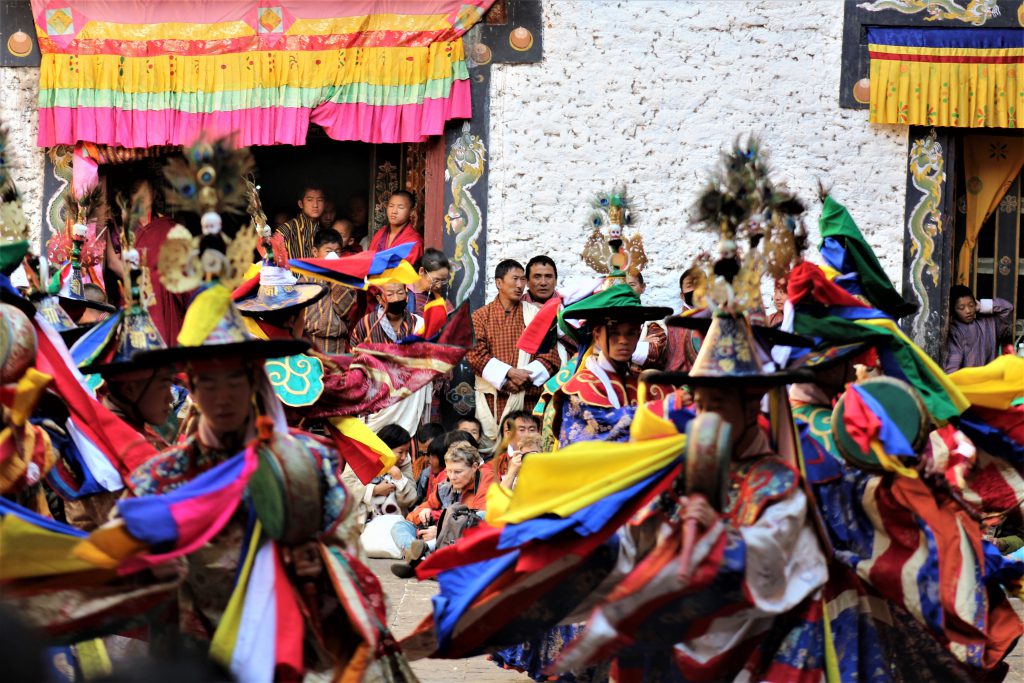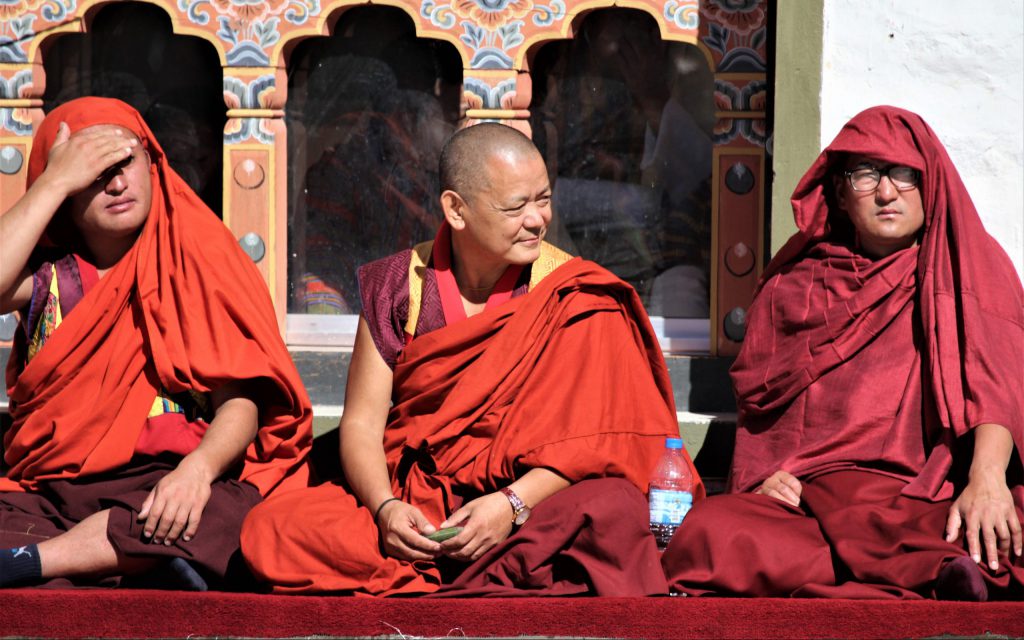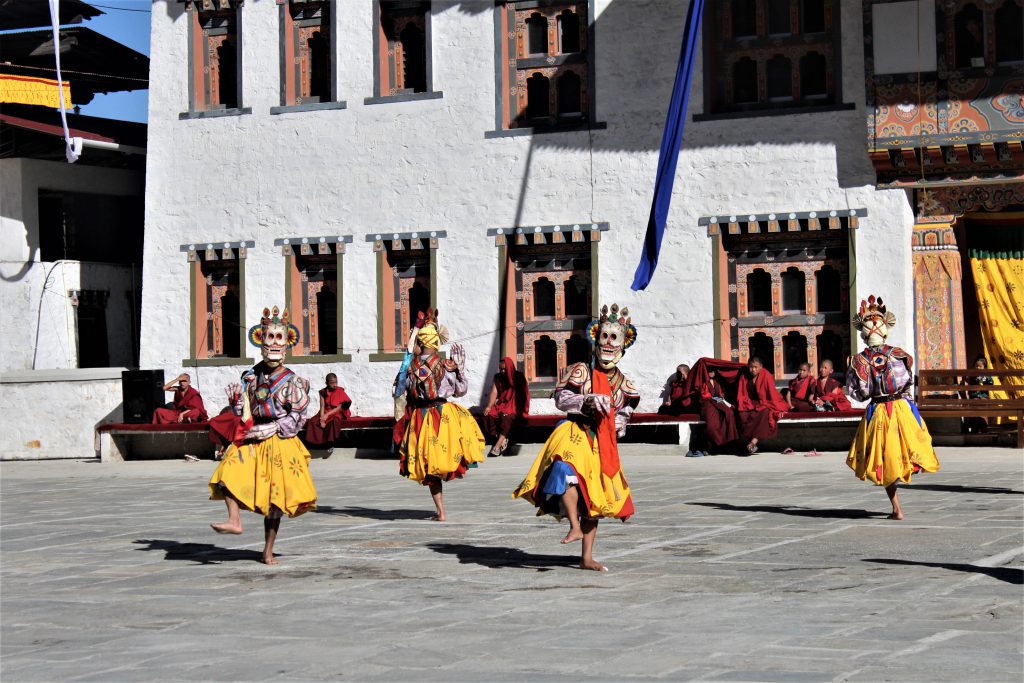This program traverses through spectacles of western, central & eastern Bhutan culminating with highlight of Mongar & Trashigang festivals. An insightful journey offering you opportunity to absorb the happiness of Bhutan, experiencing the nature at its best & enjoying delightful life of small towns and villages all along the trail apart from visit of magnificent Dzongs and sites of cultural and natural significance.
The sacred festivals of Bhutan are one of the main sources of promoting Gross National Happiness (GNH) as festivals assist in creating and developing positive mental attitudes and help to inspire love and compassion. These festivals apart from their enduring religious significance also provides an occasion for the locals to get together, to renew old friendships and to forge new alliances all against the backdrop of a colourful religious ceremony. The last part of this fascinating tour ends with grandeur & excitement of Mongar & Trashigang festivals, a unique and lifetime experience.
Day 1
Day 01: Arrive Paro by Air
The flight to Paro is one of the most spectacular in entire Himalayas. Whether flying along the Himalayan range from Kathmandu or over the foothills from Kolkatta, the journey offers fascinating views and an exciting descent into the Kingdom. Bhutan’s first gift as you disembark from the aircraft will be cool, clean fresh mountain air. After immigration formalities and baggage collection, you will be met by our representative, and afterwards transfer to the hotel.
The beautiful valley of Paro encapsulates within itself a rich culture, scenic beauty and hundreds of myths and legends. It is home to many of Bhutan’s oldest temples and monasteries, National Museum and country’s only airport. Mount. Chomolhari (7,314m) reigns in white glory at the northern end of the valley and its glacial water plunge through deep gorges to form Pa Chhu (Paro river). Paro is also one of the most fertile valleys in the Kingdom producing a bulk of the locally famous red rice from its terraced fields.
This afternoon is dedicated for exploring Paro and its surrounding.
Visit Ta Dzong, originally built as Watchtower, which now houses National Museum. The extensive collection includes antique thangkha paintings, textiles, weapons & armour, household objects and a rich assortment of natural and historic artifacts.
Afterwards, walk down a hillside trail to visit Rinpung Dzong, which has a long and fascinating history. Built in 1646 by Shabdrung Ngawang Namgyal, the first spiritual and temporal ruler of Bhutan, the Dzong houses the monastic body of Paro, the office of the Dzongda (district administrative head) and Thrimpon (judge) of Paro district.
Later visit Kyichu Lhakhang, one of the oldest and most sacred monasteries of the country associated with introduction of Buddhism in Bhutan.
Overnight at the hotel in Paro. (Altitude 2,280m)
Day 2
Day 02: Paro
After breakfast, take a short drive to Satsam Chorten (trail head point) for a walking excursion to Tiger’s Nest (Taktsang Lhakhang) (approx. 5 hours walk). This most famous of Bhutan’s monasteries is perched on the side of a cliff 900m above the Paro valley floor. It is said that Guru Rinpoche arrived here on the back of a tigress, and meditated at this place, hence the monastery is also called ‘Tiger’s Nest’. This site, which has long been recognized as a most sacred place, was visited by Shabdrung Ngawang Namgyal in 1646, the religious and temporal ruler of Bhutan. It is a place of pilgrimage which Bhutanese try to visit at least once in a lifetime.
Later in the afternoon drive to the base of Drukgyel Dzong, the ruined fortress. On a clear day, there is fascinating view of Mount. Chomolhari (7,314m) from the village below the fortress. Nearby visit a traditional farmhouse which provides opportunity to understand local culture, traditions, way of life especially of village folks.
Overnight at the hotel in Thimphu (Altitude 2,280m).
Day 3
Day 03: Paro – Thimphu (55km, approx. 1.1/2-hour drive)
After breakfast, drive to Thimphu, the capital town of Bhutan with en-route stop at Chuzom, the confluence of Thimphu and Paro rivers. Three different style of stupas; Tibetan, Nepalese and Bhutanese adorn this confluence. Shortly before reaching Chuzom, you will see on your left Tschogang Lhakhang, “the temple of the excellent horse”. It is a private temple, built in 15th century, as the result of visitation from Balaha, the excellent horse, a manifestation of Chenrezig, the compassionate Buddha.
Drive further and five miles before Thimphu, visit to Simtokha Dzong, the oldest fortress of the country which now houses the School for Buddhist studies.
Later in the afternoon in Thimphu visit the following:
Simply Bhutan: It is an exclusive project under the Bhutan Youth Development Fund (YDF), built to offer a unique experience to its visitors. Simply Bhutan is a living museum and studio encapsulating the cultural heritage of the Bhutanese people. A distinctive feature of Simply Bhutan is that it fully operated by young people and job seekers, who receive here on the job training in basic business & management skills, customer care and other spheres of life. The fund generated through Simply Bhutan is utilized to run many of the youth development programmes for vulnerable and disadvantaged youth under YDF.
Takin Preserve: The Takin is the national animal of Bhutan and looks like a cross between a cow and a goat. Legend says that the animal was created by the great Buddhist yogi, Drupa Kunley, and it can be found only in Bhutan and nearby areas. Taxonomists place the animal in a category of its own as it is not similar enough to any other animal to fit established categories.
King’s Memorial Chorten continuously circumambulated by people, murmuring mantras and spinning their prayer wheels. Construction of this landmark was the idea of Bhutan’s third king, His Majesty Jigme Dorji Wangchuk (the father of modern Bhutan) who has wished to erect monument to world peace and prosperity. Completed in 1974 after his untimely death, it serves both as a memorial to the Late King and as a monument to peace.
Changangkha Lhakhang: It is a fortress like temple and monastic school perched on a ridge above Thimphu, south of Motithang. The temple was established in 12th century on a site chosen by Lama Phajo Drugom Shigpo, who came from Tibet. The central statue here is Chenrezig in a manifestation with 11 heads. From temple courtyard, there is fascinating view of Thimphu valley.
Overnight at the hotel in Thimphu. (Altitude 2,320m)
Day 4
Day 04: Thimphu
Morning after breakfast visit of:
Buddha Point (Kuenselphodrang): You can pay your obeisance and offer prayers to the Buddha, the largest statue in the country and then walk around and take a glimpse of the valley.
National Library, which holds a vast collection of ancient Buddhist texts and manuscripts, some dating back several hundred years, as well as modern academic books mainly on Himalayan culture and religion.
Institute for Zorig Chusum: Commonly known as Arts & Crafts School or Painting School, the Institute offers a six-year course on the 13 traditional arts and crafts of Bhutan. On a visit, one can see students learning the various skills taught at the school.
Textile Museum: is worth a visit to get to know the living national art of weaving. Exhibitions introduce the major weaving techniques, styles of local dress and textiles made by women and men.
After lunch, explore Local Crafts Bazaar, to browse through example of Bhutan’s fine traditional arts. Here you can buy hand-woven textiles, thangkha paintings, masks, ceramics, slate and wood carvings, jewelry, interesting items made from local materials.
Then drive to Drubthob Goema / Zilukha Nunnery. Perched on a promontory, overlooking picturesque Trashichhoedzong and Golf course, it is the only nunnery in capital known as Zilukha Anim Dratsang, once belonged to the Drubthob (Realized one) Thang Thong Gyalpo often referred to as The King of the open field. You may interact here with some of the nuns who have devoted their life to spirituality and Buddhism.
Evening visit to Trashichhoedzong. This impressive fortress/monastery houses Secretariat building, the throne room of His Majesty, the King and various government offices. It is also the summer residence of Chief Abbot and central monk body.
Overnight at the hotel in Thimphu. (Altitude 2,320m)
Day 5
Day 05: Thimphu – Punakha (75km, approx. 2.1/2-hour drive)
After breakfast, drive up to Dochu-la pass (3,088m/ 10,130 ft) stopping briefly here to take in the view and admire the chorten, mani wall, and prayer flags which decorate the highest point on the road. If skies are clear, the following peaks can be seen from this pass (left to right): Masagang (7,158m), Tsendagang (6,960m), Terigang (7,060m), Jejegangphugang (7,158 m ), Kangphugang (7,170 m ), Zongphugang (7, 060 m ), a table mountain that dominates the isolated region of Lunana – finally Gangkar puensum, the highest peak in Bhutan at 7,497m.
Post lunch take a short excursion to Chimi Lhakhang. Situated on a hillock in the centre of the valley, this temple is dedicated to Lama Drukpa Kuenley, who in the late 15th century used humour, songs and outrageous behaviour to dramatise his teachings and due to this also known as ‘Divine Madman’. This temple is also known as the temple of fertility. It is widely believed that couples who do not have children and wanting one, if they pray at this temple, they are usually blessed with a child very soon. It is about 30-minute walk across field from the road to the temple.
Then visit the Punakha Dzong. Built strategically at the junction of Pho Chhu and Mo Chhu rivers in 1637 by Shabdrung Ngawang Namgyal to serve as the religious and administrative centre of the region, Punakha Dzong has played an important role in Bhutan’s history. Damaged by four catastrophic fires and an earthquake, the Dzong has been fully restored by the present King.
Overnight at the Hotel in Punakha. (Altitude 1,300m)
Day 6
Day 06: Punakha – Gangtey (85km, approx. 3-hour drive)
After breakfast drive to Gangtey. The valley of Gangtey is one of the most beautiful spots in Bhutan. The surprise of finding such a wide, flat valley without any trees after the hard climb through dense forests is augmented by an impression of vast space, an extremely rare experience in Bhutan where most of the valleys are tightly enclosed.
Afternoon visit the Gangtey Gompa. Perched on a small hill that rises from the valley floor, the Gangtey Monastery is the only Nyingmapa monastery on the western side of the Black Mountain’s and also the biggest Nyingmapa monastery in Bhutan. The Monastery is surrounded by a large village inhabited mainly by the families of the 140 Gomchens who take care of the Monastery.
Then a walking excursion to Gangtey Nature Trail. This pleasurable walk will give you a nice feel of Phobjikha valley. From the small hilltop overlooking Gangtey Goemba, you head downhill through flower meadows to Semchubara village and from here through beautiful forests and into the open valley. The trail ends at local community school after passing a chorten and Khewa Lhakhang. (approx. 5.5km, 2 hours walk).
Overnight at the hotel in Gangtey. (Altitude 3,000m)
Day 7
Day 07: Gangtey – Trongsa (85km, approx. 3-hour drive)
After breakfast, visit Black Neck Crane Information Centre. Situated on the edge of the forest and wetland along the main road of Phobjikha valley, the black-necked crane information Centre has an observation room equipped with high power telescope and spotting scopes for catching the best view of the cranes. The centre also offers display information that outline the natural and cultural history of the area. There is a small gift shop, which sells handicrafts produced by the local people.
Then continue on to Trongsa across Pele-la pass (3,300m/10,830 ft), the traditional boundary between east and west. The pass is marked by a large white chorten prayer flags. There is an abrupt change in vegetation at this point, with mountain forest replaced by high altitude dwarf bamboo.
Drive further and stopping en route at Chendbji Chorten, patterned on Kathmandu’s Swayambhunath Stupa, with eyes panted at four cardinal points. It was built in the 18th century by Lama Shida from Tibet, to cover the remains of an evil spirit that was subdued at this spot.
Afternoon visit the Trongsa Dzong. Built in 1648 it was the seat of power over central and eastern Bhutan. Both the first and second Kings of Bhutan ruled the country from this ancient seat. All four Kings were invested as Trongsa Penlop (‘governer’) prior to ascending the throne, and the present Crown Prince now holds the post. The Dzong is a massive structure with many levels, sloping down the contours of the ridge on which it is built.
Overnight at the hotel in Trongsa. (Altitude 2,300m)
Day 8
Day 08: Trongsa – Bumthang (68km, approx. 2.1/2-hour drive)
Morning after breakfast visit the Ta Dzong, a cylindrical stone structure rising five storeys, built in 1652 by Chogyal Minjur Tempa, a task entrusted to him by Zhabdrung Ngawang Namgyal. After more than 350 years, it has been resurrected into a classy museum, that represents a tasteful blend of tradition and modernity. The Ta Dzong is a living museum and the main lhakhang in the Utse is dedicated to the Maitreya Buddha (Gyaltsab Jampa), also known as the Future Buddha. A Khesar Lhakhang is dedicated to Khesar of Ling.
Then Proceed to Bumthang, over the Yutong-la pass (3,400m/ 11,155 ft). The road winds steeply up to the pass, 28 km from Trongsa, then runs down through coniferous forest into a wide, open cultivated valley known as the Chumey valley. Also visit Yathra (woolen fabric) weaving centre in Chumey valley.
Afternoon proceed to visit Jambay Lhakhang. This monastery was built in the 7th century by Tibetan King, Songtsen Gampo. It is one of the 108 monasteries built by him to subdue evil spirits n the Himalayan region. Its present architectural appearance dates from the early 20th century.
Then drive Kurje Lhakhang, consisting of three temples. The one on the right was built in 1652 on the rack face where Guru meditated in the 8th century. Second temple is built on the site of a cave containing a rock with the imprint of Guru’s body and is therefore considered the most holy. The third temple was built in 1990s by Ashi Kesang, the Queen Mother. These three temples are surrounded by a 108 chorten wall.
Evening take a stroll in the heart of Choekhor valley, exploring local shops and market.
Overnight at the hotel in Bumthang. (Altitude 2,600m)
Day 9
Day 09: Bumthang
Bumthang is the general name given to combination of four valleys – Chumey, Choekhor, Tang and Ura with altitude varying from 2,600m to 4,000m. It is home to many of prominent Buddhist temples and monasteries.
After breakfast, excursion to visit:
Tangbi Goemba: Founded in 1470 by Shamar Rinpoche of the Kagyupa religious school, the temple has two sanctuaries and a temple of terrifying deities. The sanctuary on the ground floor contains statues of past, present and future Buddha and three clay statues probably dating end of the 15th century. On the upper floor, the vestibule contains two remarkable paintings of Guru Rinpoche’s heaven and the Buddha Amitabh’s heaven.
Ngang Lhakhang: Ahead of Tangbi Goemba is the small region of Ngang Yul (Swan Land) and this temple here is 100 m above the valley floor. The site was visited by Guru Rinpoche and present temple was built in the 15th century by Lama Namkha Samdup, a contemporary of Pema Lingpa.
Jakar Dzong, founded by great grandfather of the first Shabdrung is later in sightseeing schedule. This Dzong was initially built as a monastery in 1549. It was upgraded after the Shabdrung had firmly established his power in 1646. The Dzong is now used as administrative centre for Bumthang valley and houses the regional monk body.
Then drive across the river to Tamshing Lhakhang. Located across the river from Kurje Lhakhang, this temple was founded in 1501 by Terton Pema Lingpa, the re-incarnation of Guru Padsambhava. The monastery has very ancient religious paintings like 1,000 Buddhas and 21 Taras (female form of Buddhistava). The temple was restored at the end of the 19th century.
Evening visit to Lhodrak Kharchhu Monastery. Located above the main town, about 3 km from Chamkhar town, the monastery was founded by Namkhai Nyingpo Rinpoche in 1984 who was recognized at a very young age by H.H. the 14th Dalai Lama and H.H. 16th Karmapa as the reincarnation of a Tibetan lama whose spiritual lineage dates back to the nearest disciples of the great 9th century master. Since then the monastery has developed considerably with increase in number of monks to almost four hundred. The monastey has become part of an extensive effort to preserve and revitalize Tibetan culture.
Overnight at the hotel in Bumthang. (Altitude 2600m)
Day 10
Day 10: Bumthang – Mongar (198 km, approx. 7-hour drive)
The journey continues eastwards, winding through more rugged terrain. The drive to Mongar takes about 7 hours with spectacular view en route. We will drive up into the hills above the valley and then past Ura village, before climbing sharpely to the highest point on Bhutan’s motorable road network, Thrumshing-la pass (4,000m/13,125 ft).
From here, the road gradually descends to the alpine valley of Sengor, with wonderful views of cascading waterfalls and the hills of eastern Bhutan along the way. Vegetation changes from alpine to subtropical with the loss of height, and bamboos and luxuriant ferns overhang the road as we drop down to the valley floor. The descent stops at 700m/2,300ft, where we cross the Kurichu river. We ascend again through pine forests, maize fields and eastern hamlets to reach Mongar town, high on a gentle slope above the valley.
Picnic lunch at a scenic spot en route to Mongar.
Drive onward to Mongar. It is site of one of Bhutan’s newest Dzong built in 1930s. Yet the Dzong is built in the same method and traditions of all the other Dzongs; no drawings and nails have been used. A visit gives visitors an impression of how traditional Bhutanese architecture has continued to thrive through the centuries.
Overnight at the hotel in Mongar. (Altitude 1620m)
Day 11
Day 11: Mongar – Trashigang (96 km, approx. 3-hour drive)
Morning after breakfast, witness Mongar Tshechu.
Mongar Tshechu is the most exciting annual festival held for three days, besides several local festivals in the region. Celebrated inside the Dzong, it is witnessed by people from as far as Trashigang, Trashiyangtse and Lhuentse. The festival offers numerous mask dances and is one of the most important events, the area has to offer.
Afternoon drive to Trashigang. This trip of about 96 km takes only 3 hours. The first part of the journey is through leafy forest filled with ferns. After driving through the Kori-la pass (2,450m/8,040ft), marked by a pretty chorten and a mani wall, we descend rapidly through corn fields and banana groves to reach the famous road zigzags just below Yadi, a fairly recent and now fast growing settlement.
After zigzagging down the hillside, the road east along the Gamri river. A turnoff on the left side up to Drametse. The temple, perched on top of a steep hill above the village, was founded by Choeden Zangmo and is the most important monastery of eastern Bhutan. This is the place of origin of the famous Drametse Nga Chham, a masked dance with druns. About 30km. Onwards lies Trashigang (1,100m/3,610ft), which clings to a steep hillside above the Gamri river. Trashigang is the principal township of the biggest and most populated district in the country.
Overnight at the hotel in Trashigang. (Altitude 1,150m)
Day 12
Day 12: Trashigang
After breakfast, witness Trashigang Tshechu. The annual three-day distinctive Trashigang Tshechu is one of the biggest festivals in eastern Bhutan and held at Trashigang Dzong, during the 7th to 11th day of the tenth month of the Bhutanese calendar. The Tshechu is alsoattended by the Brokpas, a semi-nomadic people those reside in the valleys of Merak and Sakteng, the Khengpa community and people from as far as Samdrup Jongkhar, Pema Gatshel and Trashiyangtse.
Preparations for the Tshechu begin two days prior to the actual festival. On the 7th day of the month the monks perform ceremonial ablutions. On 8th day, they have rehearsals in preparation for the Tshechu. Then on the 9th day of the month the Tshechu formally begins. On the 10th day, the Thongdroel (large tapestry) of Neten Chudrug (Sixteen Arhats) is unfurled amidst a flurry of mask dances. On the final day, the old Thongdroel of Guru Tshengyed (eight manifestation of Guru Rinpoche) is displayed. The unfurling is accompanied by the performance of Guru Tshengyed Chhams.
Also visit Trashigang Dzong, standing at the extreme end of a rocky outcrop far above the river gorge. It serves as the administrative seat for the district and part of the dzong is occupied by the local Drukpa monastic community.
Overnight at the hotel in Trashigang. (Altitude 1150m)
Day 13
Day 13: Trashigang — Samdrup Jongkhar (180 km, approx. 6-hour drive)
Morning witness Trashigang Tshechu. Then drive onward to Samdrup Jongkhar, south eastern border town of Bhutan.
Trashigang — Samdrup Jongkhar road completed in 1965 and the journey takes about 6 hours. Along the way, pass by Sherubtse College, the only college in country founded in 1978. Also visit the Zangtho Pelri temple built in 1978 by the late Minister of Home Affairs. It represents Guru Rinpoche’s paradise. Driving ahead, pass through Khaling village to visit the Blind School and Weaving Centre. Deothang, 80 kms from Khaling is the centre of Technical training college and road maintenance headquarters for the east. From here the road descends fairly rapidly to the plain through a dense tropical forest with an abundance of teak, bamboo and ferns.
Overnight at the lodge in Samdrup Jongkhar. (Altitude 280m)
Day 14
Day 14: Depart Samdrup Jongkhar
After breakfast transfer to Bhutan border where you will be picked up by representative from India for onward drive to Guwahati (Assam, India).
Image Gallery
